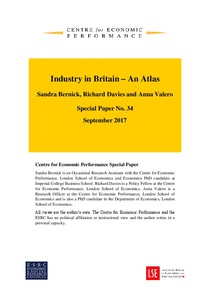Industry in Britain - An atlas
"Living near a productive company can have considerable economic benefits. It means the chance of well-paid jobs, creates opportunities for suppliers of goods and services, and can be a boost to local retailers. This common-sense economic logic explains why policymakers consistently worry about...
| Main Authors: | , , |
|---|---|
| Institution: | ETUI-European Trade Union Institute |
| Format: | TEXT |
| Language: | English |
| Published: |
London
2017
LSE |
| Subjects: | |
| Online Access: | https://www.labourline.org/KENTIKA-19394638124911128109-industry-in-Britain---an-atlas.htm |
| Summary: | "Living near a productive company can have considerable economic benefits. It means the chance of well-paid jobs, creates opportunities for suppliers of goods and services, and can be a boost to local retailers. This common-sense economic logic explains why policymakers consistently worry about the uneven spread of industry in Britain and, from time to time, conclude that it inefficient and unfair and that something new must be done. Now is one of those moments, with the government shortly set to launch a new “Industrial Strategy” which looks likely to include a new approach to regional policy. But while there is agreement across Britain’s political parties that the distribution of industry is a problem, little new analysis on the location and performance of British firms with an explicitly regional focus has been published recently. This paper, part of ongoing work on the economics of British industry at the LSE’s Centre for Economic Performance, starts to fill that gap. We present maps and charts setting out the latest data on firm location, together with geographic measures of employment, productivity, and innovation. Ten stylised facts emerge from our analysis, many of which challenge the prevailing wisdom: Finance is far less London-centric than the creative industries; the South-East is not the country’s productivity engine, rather a band stretching west from the capital towards Bristol is; the East of England stands out in terms of R&D intensity; and in addition to the North-South divide, disparities between coastal and inland areas are concerning. This clarification of the starting point is just the first step in a data-driven approach to industrial policy. Bigger questions—in particular analysis of the ideal spread of industry that policy should target, and the best tools to get there—loom large and also require new analysis." |
|---|---|
| Physical Description: | 48 p. Digital |

